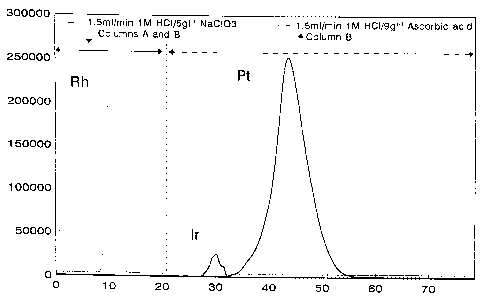Une partie des informations de ce site Web a été fournie par des sources externes. Le gouvernement du Canada n'assume aucune responsabilité concernant la précision, l'actualité ou la fiabilité des informations fournies par les sources externes. Les utilisateurs qui désirent employer cette information devraient consulter directement la source des informations. Le contenu fourni par les sources externes n'est pas assujetti aux exigences sur les langues officielles, la protection des renseignements personnels et l'accessibilité.
L'apparition de différences dans le texte et l'image des Revendications et de l'Abrégé dépend du moment auquel le document est publié. Les textes des Revendications et de l'Abrégé sont affichés :
| (12) Brevet: | (11) CA 2314697 |
|---|---|
| (54) Titre français: | SEPARATION DE METAUX DU GROUPE DU PLATINE |
| (54) Titre anglais: | SEPARATION OF PLATINUM GROUP METALS |
| Statut: | Durée expirée - au-delà du délai suivant l'octroi |
| (51) Classification internationale des brevets (CIB): |
|
|---|---|
| (72) Inventeurs : |
|
| (73) Titulaires : |
|
| (71) Demandeurs : |
|
| (74) Agent: | SMART & BIGGAR LP |
| (74) Co-agent: | |
| (45) Délivré: | 2011-04-19 |
| (22) Date de dépôt: | 2000-07-28 |
| (41) Mise à la disponibilité du public: | 2001-02-05 |
| Requête d'examen: | 2005-05-18 |
| Licence disponible: | S.O. |
| Cédé au domaine public: | S.O. |
| (25) Langue des documents déposés: | Anglais |
| Traité de coopération en matière de brevets (PCT): | Non |
|---|
| (30) Données de priorité de la demande: | ||||||
|---|---|---|---|---|---|---|
|
La présente invention concerne des procédés et des appareils permettant la interséparation des métaux du groupe platine. En particulier, cette invention permet pour la première fois une séparation claire de métaux insolubles comme le rhodium, l'iridium et le ruthénium, les uns des autres et du platine, ainsi que d'autres métaux du groupe platine, en utilisant la chromatographie sur gel et le contrôle de l'état d'oxydation du groupe de métaux du platine.
The present invention relates to methods and apparatus for the
interseparation of platinum group metals. In particular, the invention allows
for
the first time a clear separation of the insoluble metals rhodium, iridium and
ruthenium from one another and from platinum, in addition to other platinum
group metals, using gel chromatography and control of the oxidation state of
the
platinum group metals.
Note : Les revendications sont présentées dans la langue officielle dans laquelle elles ont été soumises.
Note : Les descriptions sont présentées dans la langue officielle dans laquelle elles ont été soumises.

2024-08-01 : Dans le cadre de la transition vers les Brevets de nouvelle génération (BNG), la base de données sur les brevets canadiens (BDBC) contient désormais un Historique d'événement plus détaillé, qui reproduit le Journal des événements de notre nouvelle solution interne.
Veuillez noter que les événements débutant par « Inactive : » se réfèrent à des événements qui ne sont plus utilisés dans notre nouvelle solution interne.
Pour une meilleure compréhension de l'état de la demande ou brevet qui figure sur cette page, la rubrique Mise en garde , et les descriptions de Brevet , Historique d'événement , Taxes périodiques et Historique des paiements devraient être consultées.
| Description | Date |
|---|---|
| Inactive : Périmé (brevet - nouvelle loi) | 2020-07-28 |
| Représentant commun nommé | 2019-10-30 |
| Représentant commun nommé | 2019-10-30 |
| Requête pour le changement d'adresse ou de mode de correspondance reçue | 2018-01-12 |
| Accordé par délivrance | 2011-04-19 |
| Inactive : Page couverture publiée | 2011-04-18 |
| Préoctroi | 2011-02-03 |
| Inactive : Taxe finale reçue | 2011-02-03 |
| Un avis d'acceptation est envoyé | 2010-09-01 |
| Lettre envoyée | 2010-09-01 |
| Un avis d'acceptation est envoyé | 2010-09-01 |
| Inactive : Approuvée aux fins d'acceptation (AFA) | 2010-08-30 |
| Modification reçue - modification volontaire | 2010-06-08 |
| Inactive : Dem. de l'examinateur par.30(2) Règles | 2009-12-10 |
| Modification reçue - modification volontaire | 2008-09-24 |
| Inactive : Dem. de l'examinateur par.30(2) Règles | 2008-04-04 |
| Inactive : CIB attribuée | 2008-04-03 |
| Inactive : CIB de MCD | 2006-03-12 |
| Inactive : CIB de MCD | 2006-03-12 |
| Lettre envoyée | 2005-05-27 |
| Requête d'examen reçue | 2005-05-18 |
| Exigences pour une requête d'examen - jugée conforme | 2005-05-18 |
| Toutes les exigences pour l'examen - jugée conforme | 2005-05-18 |
| Inactive : Page couverture publiée | 2001-02-05 |
| Demande publiée (accessible au public) | 2001-02-05 |
| Inactive : Demandeur supprimé | 2000-11-07 |
| Lettre envoyée | 2000-11-07 |
| Inactive : Transfert individuel | 2000-10-02 |
| Inactive : CIB en 1re position | 2000-09-13 |
| Inactive : Lettre de courtoisie - Preuve | 2000-08-29 |
| Inactive : Certificat de dépôt - Sans RE (Anglais) | 2000-08-24 |
| Demande reçue - nationale ordinaire | 2000-08-23 |
Il n'y a pas d'historique d'abandonnement
Le dernier paiement a été reçu le 2010-06-18
Avis : Si le paiement en totalité n'a pas été reçu au plus tard à la date indiquée, une taxe supplémentaire peut être imposée, soit une des taxes suivantes :
Les taxes sur les brevets sont ajustées au 1er janvier de chaque année. Les montants ci-dessus sont les montants actuels s'ils sont reçus au plus tard le 31 décembre de l'année en cours.
Veuillez vous référer à la page web des
taxes sur les brevets
de l'OPIC pour voir tous les montants actuels des taxes.
Les titulaires actuels et antérieures au dossier sont affichés en ordre alphabétique.
| Titulaires actuels au dossier |
|---|
| ANGLO AMERICAN PLATINUM CORPORATION LIMITED |
| Titulaires antérieures au dossier |
|---|
| CHRISTOPHER STANLEY SMITH |